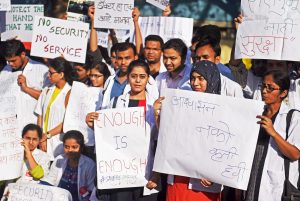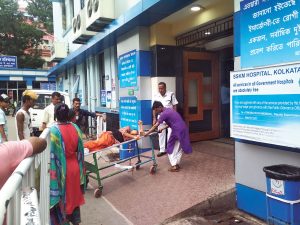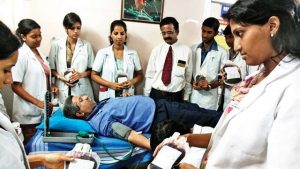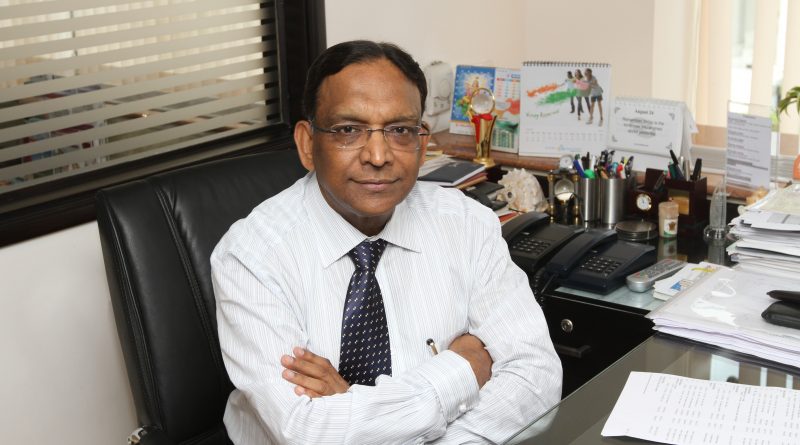Victimized FOR System’s Failure
There are diverse causes for the increase in violence against medical personnel that recently saw a nationwide doctors’ strike. Prominent out of them is the rising cost of healthcare that causes many families to go into debt. Anger and grief at losing someone despite spending beyond their means is understandable, but unfortunately it often culminates in violence…
By Dr Vinay Aggarwal
 There are various types of healthcare violence like verbal abuse, mobbing, threats, psychological harassment, physical violence, vandalism and cyber trolling. Healthcare violence makes it difficult for doctors to work under stress, and even families of doctors feel threatened. Though it involves offences which are punishable under the provisions of the Indian Penal Code, 1860, public nuisance under Section 268 & 269 IPC, any type of hurt under Section 319, 323 & 324 IPC while grievous hurt under Section 320, 325 & 326 IPC and endangering life or personal safety of others under Section 336, 337 & 338 IPC, there is inadequate enforcement of these provisions on the ground.
There are various types of healthcare violence like verbal abuse, mobbing, threats, psychological harassment, physical violence, vandalism and cyber trolling. Healthcare violence makes it difficult for doctors to work under stress, and even families of doctors feel threatened. Though it involves offences which are punishable under the provisions of the Indian Penal Code, 1860, public nuisance under Section 268 & 269 IPC, any type of hurt under Section 319, 323 & 324 IPC while grievous hurt under Section 320, 325 & 326 IPC and endangering life or personal safety of others under Section 336, 337 & 338 IPC, there is inadequate enforcement of these provisions on the ground.
According to a study by the Indian Medical Association, over 75% of doctors have faced violence at work. A lady doctor was killed by the husband of a pregnant woman who was admitted in a serious condition. She was referred to another hospital but died before she could be shifted. The husband entered the consultation chamber of the lady doctor with three accomplices and attacked her with a sword. In 2014, in Mansa district of Punjab, a doctor’s clinic was burnt following death of a boy who was referred to a tertiary hospital but died. Violence against doctors and other medical practitioners in India has been reported as an increasing problem. On an average, one in 2 doctors faces violence at public hospitals.
With poor infrastructure and no increase in the number of posts for government doctors over the past many decades, despite an increasing population, the public healthcare system is on the verge of collapse. Violence against the health service provider is only a symptom of this crippling underlying malady.
 Violence is much more common in healthcare than in other industries, and may take a variety of forms. Violent events can happen with anyone. The doctors are usually unprepared to face such episodes. There are many ways to reduce the potential for violence and total episodes. One of the most serious problems in worldwide healthcare, it needs to be addressed in a well-thought-out way.
Violence is much more common in healthcare than in other industries, and may take a variety of forms. Violent events can happen with anyone. The doctors are usually unprepared to face such episodes. There are many ways to reduce the potential for violence and total episodes. One of the most serious problems in worldwide healthcare, it needs to be addressed in a well-thought-out way.
Violence may stem from patient dissatisfaction with care, costs associated with insurance premiums, unrealistic expectations, and overworked and underpaid hospital staff, as well as the rising cost of healthcare due to the government’s inability to subsidize hospital operations. Lack of a third-party formal dispute resolution system in many hospitals has been suggested as a factor, and the acceptance of bribes or good-faith money in the form of red packets has been implicated. Media coverage, and a lack of health literacy amongst the population, who may often seek unnecessary high-level care, are also some of the factors.
 India is not the only country facing violence against its medical practitioners. This is a global phenomenon, today. In the USA, between 1980 and 1990, over 100 healthcare workers died as a result of violence. Another survey conducted in 170 university hospitals revealed that 57% of all emergency room employees had been threatened with a weapon over a 5-year period before the survey. The main reason behind violence is ignorance about disease and prognosis, lack of knowledge regarding medical science. Today mob mentality has become a pre-dominant trait.
India is not the only country facing violence against its medical practitioners. This is a global phenomenon, today. In the USA, between 1980 and 1990, over 100 healthcare workers died as a result of violence. Another survey conducted in 170 university hospitals revealed that 57% of all emergency room employees had been threatened with a weapon over a 5-year period before the survey. The main reason behind violence is ignorance about disease and prognosis, lack of knowledge regarding medical science. Today mob mentality has become a pre-dominant trait.
There is lack of communication and overwork leading to numerous patients and understaffing of doctors. The junior doctors mostly get attacked as first responders in critical situation, because they lack training in proper communication. There is also lack of surveillance, security and restriction on movement of multiple attendants inside hospital premises. The government should be very transparent with lack of institutional/organisational policies, and prepare action plans to deal with such violence.
Many of the reported attacks on doctors have been by patients or their family members who were dissatisfied with the care they received. In a recent incident, patient suffering from ankylosing spondylitis and tuberculosis used a knife to attack several doctors in a private hospital of western Uttar Pradesh after the patient was refused a drug treatment that he had requested. Unfortunately, one doctor who had not been involved in the patient’s case died.
Like India, the doctors in China are not unique in facing violence. However, the scale, frequency and viciousness of attacks have shocked the world. Seventy percent of physicians and 90% of support staff working in a hospital emergency room in Israel reported violent acts, mostly verbal abuse. Violence in Bangladesh has been reported to occur mostly in the public hospital setting, but in the private healthcare setting as well. In a study of 675 physicians in training in nine tertiary institutes across Pakistan, 76% reported verbal or physical violence. Another study from Pakistan reported that 74% of respondents in a public sector healthcare facility in Lahore were victims of violence during the preceding 12 months.
Innumerable incidents of violence against doctors are reported nearly on a daily basis across India, some resulting in grievous injuries. Even institutions such as the All India Institute of Medical Sciences (AIIMS), New Delhi, the premier medical institute of the country is not spared. Nineteen states of India have some kind of Medicare Service Persons and Medicare Service Institutions (Prevention of violence or damage or loss of property) Acts passed and notified in the past 10 years. Under the Right to Information (RTI) Act, the Medicos Legal Action Group Trust (MLAG) asked all senior superintendents of police in Punjab and Haryana, the two states where the Prevention of Violence against Doctors Act is in place for over 8 years, for the following information.
1. How many complaints by doctors or hospitals were registered under these Acts against patients or attendants?
2. How many of those accused of assault were punished under these Acts from 2010 to 2015.
According to the replies, most complaints were not registered as a first information report (FIR), a mandatory procedure to be followed by all police officials as per the judgment delivered by the Supreme Court of India in the case of Lalita Kumari versus the Government of Uttar Pradesh.
In a few cases where the FIR was lodged based on the complaint, it was cancelled after a compromise was reached between the aggrieved parties and a cancellation report was filed with the local magistrate. Very few cases have reached courts after filling of a challan but no person accused of assault on a medicare establishment has yet been penalized under the Medicare Service Persons and Medicare Service Institutions (Prevention of violence or damage or loss of property) Acts of Punjab and Haryana from 2010 to 2015.
Causes of violence against doctors
There are many causes for the increase in violence against medical personnel, not restricted to a general increase in aggression in society as evidenced by incidents of road rage and other acts of violence witnessed in schools and colleges across India. In India, doctors have traditionally been regarded highly by society. The present impression of private business-mindedness of some in the profession has led to a poor image of doctors. However, one of the factors that contribute to this poor image of doctors is the sensationalization of every news item, often ignoring information that would gloss over mundane details, exonerating a doctor in an incident of alleged medical negligence. A hypothetical example is that of a television reporter shouting at the medical superintendent of a Delhi hospital reeling under a load of dengue patients as to why antimalarials were not given to a patient who died of dengue. This is done with an air of ‘knowledge’ that viewers would be convinced that not giving antimalarials to a patient of dengue in shock was medical negligence of the highest order.
Among other causes of violence against doctors in India are the pathetic conditions in which patients are treated in government hospitals. There is overcrowding, long waiting time to meet doctors, absence of a congenial environment, multiple visits to get investigations done as well as consult doctors, sharing a bed by two and sometimes three patients, and poor hygiene and sanitation.
But the rising cost of healthcare is the key reason for the breakdown of the bond between doctors and their patients. Even though the costs of all medical procedures in India are many times lower than those in western countries, they are sufficiently high to cause many families to go into debt and slip below the poverty line. In a family where a regular meal takes primacy over health, anger and grief at losing someone despite spending beyond their means is understandable, but unfortunately it often culminates in violence. Whatever the provocation, justifying any violence especially against a doctor who tries to help in times of need has to be strongly condemned. There is frustration with systemic problems of government hospitals, from dysfunctional equipment to shortage of staff. Given the poor budgetary allocation for health in India, these problems are unlikely to change. Only 106415 doctors are employed by the government in India, of the 938861 doctors registered to provide healthcare to a population over 130 crore (1.33 billion). Of these, only 27355 are posted at primary health centres (PHCs), which serve the rural population. With poor infrastructure and no increase in the number of posts for government doctors over the past many decades, despite an increasing population, the public healthcare system is on the verge of collapse. Violence against the health service provider is only a symptom of this crippling underlying malady.
According to International Trade Administration, the US Department of Commerce, the Indian government’s share in the healthcare delivery market is only 20%. The remaining healthcare providers are in the private sector. The private healthcare providers consist of private practitioners, for-profit hospitals and nursing homes, and charitable hospitals. They are diverse and fragmented. Various population surveys have shown that private small and medium healthcare establishments (SMHCEs) have a dominant role in providing healthcare to the population, and it is reported that 84% of private hospitals have less than 30 beds.
According to the WHO, just 33% of Indian healthcare expenditure is from government sources and the remaining is from out-of-pocket expenditure. This out-of-pocket expense for healthcare in SMHCEs pushes many households into poverty all over India even though these are more affordable than the corporate hospitals. Insurance penetration is low and the government does not provide enough resources for free healthcare, leaving people to fend for themselves as best as they can. Many incidents of violence have occurred at the time of billing and with any decrease in the already pitiable Union Budget for health the situation is likely to deteriorate further.
Another cause of violence against doctors in India is the lack of faith in the law and order machinery and the judiciary. A person with a grievance does not trust the mechanisms of redressal provided by law. There is sometimes a perception that doctors being well connected will get away and hence there is a tendency to take the law into their own hands by resorting to violence. There is also a belief that the patient’s attendants who assault doctors will go unpunished.
Mob mentality frequently snowballs into a violent crisis in hospitals. In India, emotional turmoil due to death of a loved one is sometimes used by local politicians as an opportunity to demonstrate their political relevance by orchestrating violence at the clinical establishment. The 2-minute of fame and news coverage drives anti-social elements to often damage the social fabric during a medical accident. Unique to India, the unfortunate death of a patient is sometimes given religious and caste colour by miscreants, especially if the doctor belongs to a caste or religion different from the patient.
(The author is Past National President, Indian Medical Association and Chairman, Pushpanjali Medical Centre,
New Delhi)

